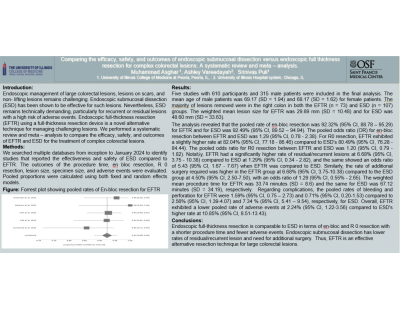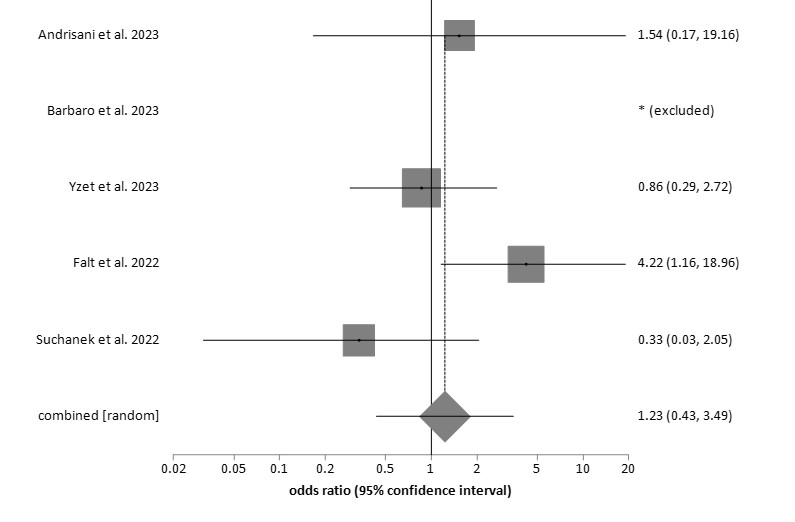Tuesday Poster Session
Category: Interventional Endoscopy
P4492 - Comparing the Efficacy, Safety, and Outcomes of Endoscopic Submucosal Dissection versus Endoscopic Full Thickness Resection for Complex Colorectal Lesions: A Systematic Review and Meta-Analysis
Tuesday, October 29, 2024
10:30 AM - 4:00 PM ET
Location: Exhibit Hall E

Has Audio

Muhammad Asghar, MD
University of Illinois College of Medicine
Peoria, IL
Presenting Author(s)
Muhammad Asghar, MD1, Ashley A. Vareedayah, MD2, Srinivas Puli, MD1
1University of Illinois College of Medicine, Peoria, IL; 2University of Illinois at Chicago, Chicago, IL
Introduction: Endoscopic management of large colorectal lesions and non-lifting lesions remains challenging. Endoscopic submucosal dissection (ESD) has been shown to be effective for such lesions but technically remains demanding. Endoscopic full-thickness resection (EFTR) using a full-thickness resection device is a novel alternative technique.
Methods: We searched multiple databases from inception to January 2024 to identify studies that reported the effectiveness and safety of ESD compared to EFTR. The outcomes of the procedure time, en bloc resection, R 0 resection, lesion size, specimen size, and adverse events were evaluated. Pooled proportions were calculated using both fixed and random effects models.
Results: Five studies with 610 participants and 315 male patients were included in the final analysis. The weighted mean lesion size for EFTR was 29.89 mm (SD = 10.48) and for ESD was 48.60 mm (SD = 33.63). The analysis revealed that the pooled rate of en-bloc resection was 92.32% (95% CI, 88.78 – 95.29) for EFTR and for ESD was 92.49% (95% CI, 89.52 – 94.94). The pooled odds ratio (OR) for en-bloc resection between EFTR and ESD was 1.29 (95% CI, 0.78 - 2.38). For R0 resection, EFTR exhibited a slightly higher rate at 82.04% (95% CI, 77.18 - 86.46) compared to ESD's 80.49% (95% CI, 76.28 - 84.44). The pooled odds ratio for R0 resection between EFTR and ESD was 1.20 (95% CI, 0.79 - 1.82). Notably, EFTR had a significantly higher rate of residual/recurrent lesions at 6.68% (95% CI, 3.75 - 10.38) compared to ESD at 1.29% (95% CI, 0.34 - 2.82), and the same showed an odds ratio of 5.43 (95% CI, 1.67 - 7.67) when EFTR was compared to ESD. Similarly, the rate of additional surgery required was higher in the EFTR group at 6.68% (95% CI, 3.75-10.38) compared to the ESD group at 4.50% (95% CI, 2.50-7.50), with an odds ratio of 1.29 (95% CI, 0.55% - 2.65). The weighted mean procedure time for EFTR was 33.74 minutes (SD = 8.6) and the same for ESD was 67.12 minutes (SD = 34.19), respectively.EFTR exhibited a lower pooled rate of adverse events at 2.24% (95% CI, 1.22-3.56) compared to ESD's higher rate at 10.85% (95% CI, 8.51-13.43).
Discussion: Endoscopic full-thickness resection is comparable to ESD in terms of en-bloc and R 0 resection with a shorter procedure time and fewer adverse events. Endoscopic submucosal dissection has lower rates of residual/recurrent lesion and need for additional surgery. Thus, EFTR is an effective alternative resection technique for large colorectal lesions.

Disclosures:
Muhammad Asghar, MD1, Ashley A. Vareedayah, MD2, Srinivas Puli, MD1. P4492 - Comparing the Efficacy, Safety, and Outcomes of Endoscopic Submucosal Dissection versus Endoscopic Full Thickness Resection for Complex Colorectal Lesions: A Systematic Review and Meta-Analysis, ACG 2024 Annual Scientific Meeting Abstracts. Philadelphia, PA: American College of Gastroenterology.
1University of Illinois College of Medicine, Peoria, IL; 2University of Illinois at Chicago, Chicago, IL
Introduction: Endoscopic management of large colorectal lesions and non-lifting lesions remains challenging. Endoscopic submucosal dissection (ESD) has been shown to be effective for such lesions but technically remains demanding. Endoscopic full-thickness resection (EFTR) using a full-thickness resection device is a novel alternative technique.
Methods: We searched multiple databases from inception to January 2024 to identify studies that reported the effectiveness and safety of ESD compared to EFTR. The outcomes of the procedure time, en bloc resection, R 0 resection, lesion size, specimen size, and adverse events were evaluated. Pooled proportions were calculated using both fixed and random effects models.
Results: Five studies with 610 participants and 315 male patients were included in the final analysis. The weighted mean lesion size for EFTR was 29.89 mm (SD = 10.48) and for ESD was 48.60 mm (SD = 33.63). The analysis revealed that the pooled rate of en-bloc resection was 92.32% (95% CI, 88.78 – 95.29) for EFTR and for ESD was 92.49% (95% CI, 89.52 – 94.94). The pooled odds ratio (OR) for en-bloc resection between EFTR and ESD was 1.29 (95% CI, 0.78 - 2.38). For R0 resection, EFTR exhibited a slightly higher rate at 82.04% (95% CI, 77.18 - 86.46) compared to ESD's 80.49% (95% CI, 76.28 - 84.44). The pooled odds ratio for R0 resection between EFTR and ESD was 1.20 (95% CI, 0.79 - 1.82). Notably, EFTR had a significantly higher rate of residual/recurrent lesions at 6.68% (95% CI, 3.75 - 10.38) compared to ESD at 1.29% (95% CI, 0.34 - 2.82), and the same showed an odds ratio of 5.43 (95% CI, 1.67 - 7.67) when EFTR was compared to ESD. Similarly, the rate of additional surgery required was higher in the EFTR group at 6.68% (95% CI, 3.75-10.38) compared to the ESD group at 4.50% (95% CI, 2.50-7.50), with an odds ratio of 1.29 (95% CI, 0.55% - 2.65). The weighted mean procedure time for EFTR was 33.74 minutes (SD = 8.6) and the same for ESD was 67.12 minutes (SD = 34.19), respectively.EFTR exhibited a lower pooled rate of adverse events at 2.24% (95% CI, 1.22-3.56) compared to ESD's higher rate at 10.85% (95% CI, 8.51-13.43).
Discussion: Endoscopic full-thickness resection is comparable to ESD in terms of en-bloc and R 0 resection with a shorter procedure time and fewer adverse events. Endoscopic submucosal dissection has lower rates of residual/recurrent lesion and need for additional surgery. Thus, EFTR is an effective alternative resection technique for large colorectal lesions.

Figure: Odds ratio comparing En bloc resection of ESD to EFTR
Disclosures:
Muhammad Asghar indicated no relevant financial relationships.
Ashley Vareedayah: Boston scientific – Consultant. Conmed – Consultant.
Srinivas Puli indicated no relevant financial relationships.
Muhammad Asghar, MD1, Ashley A. Vareedayah, MD2, Srinivas Puli, MD1. P4492 - Comparing the Efficacy, Safety, and Outcomes of Endoscopic Submucosal Dissection versus Endoscopic Full Thickness Resection for Complex Colorectal Lesions: A Systematic Review and Meta-Analysis, ACG 2024 Annual Scientific Meeting Abstracts. Philadelphia, PA: American College of Gastroenterology.
